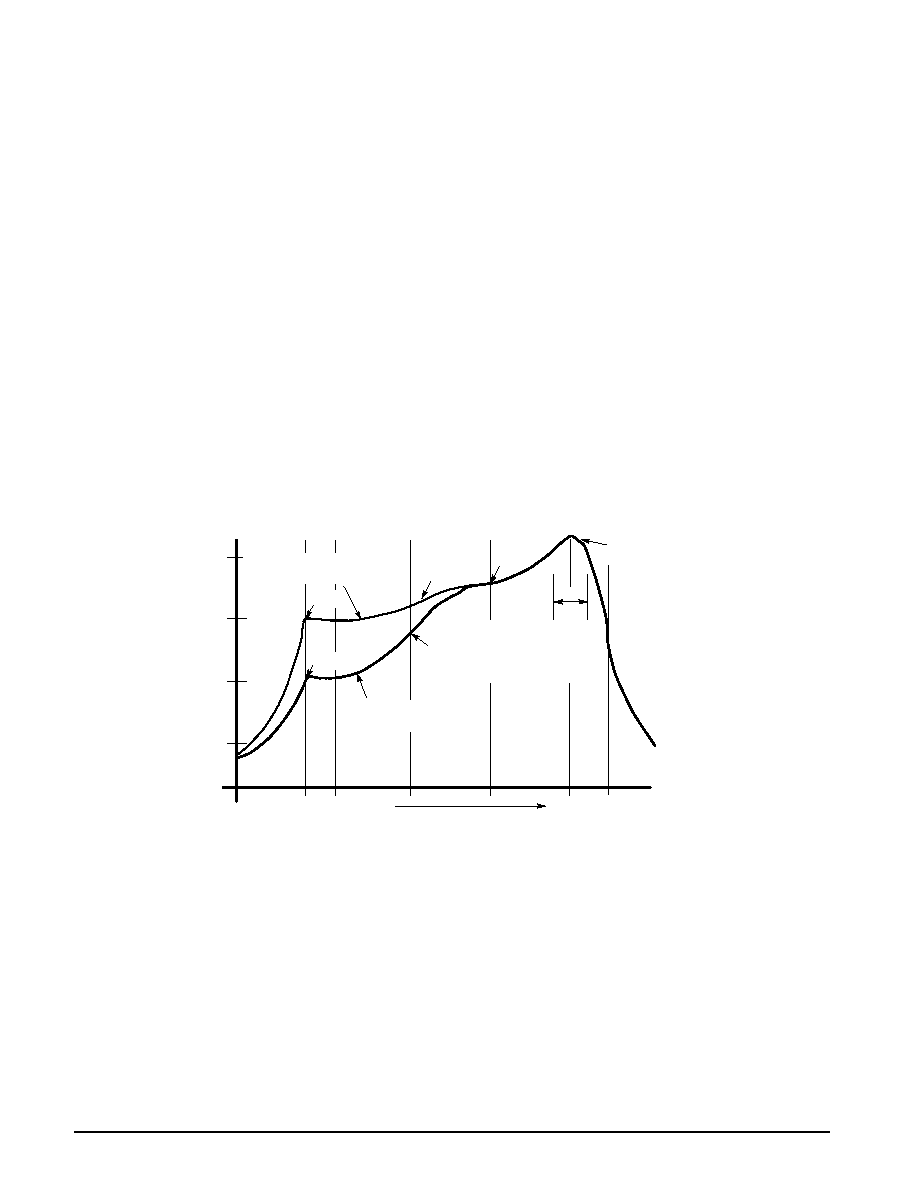- 您现在的位置:买卖IC网 > PDF目录39712 > MMQA33VT3 (MOTOROLA INC) 150 W, UNIDIRECTIONAL, 4 ELEMENT, SILICON, TVS DIODE PDF资料下载
参数资料
| 型号: | MMQA33VT3 |
| 厂商: | MOTOROLA INC |
| 元件分类: | TVS二极管 - 瞬态电压抑制 |
| 英文描述: | 150 W, UNIDIRECTIONAL, 4 ELEMENT, SILICON, TVS DIODE |
| 封装: | PLASTIC, SC-59, 6 PIN |
| 文件页数: | 6/8页 |
| 文件大小: | 104K |
| 代理商: | MMQA33VT3 |

MOTOROLA
6
MMQA Series
The soldering temperature and time should not exceed
260
°C for more than 10 seconds.
When shifting from preheating to soldering, the
maximum temperature gradient should be 5
°C or less.
After soldering has been completed, the device should
be allowed to cool naturally for at least three minutes.
Gradual cooling should be used since the use of forced
cooling will increase the temperature gradient and will
result in latent failure due to mechanical stress.
Mechanical stress or shock should not be applied during
cooling.
TYPICAL SOLDER HEATING PROFILE
For any given circuit board, there will be a group of control
settings that will give the desired heat pattern. The operator
must set temperatures for several heating zones and a figure
for belt speed. Taken together, these control settings make
up a heating “profile” for that particular circuit board. On
machines controlled by a computer, the computer remem-
bers these profiles from one operating session to the next.
Figure 9 shows a typical heating profile for use when
soldering a surface mount device to a printed circuit board.
This profile will vary among soldering systems, but it is a
good starting point. Factors that can affect the profile include
the type of soldering system in use, density and types of
components on the board, type of solder used, and the type
of board or substrate material being used. This profile shows
temperature versus time. The line on the graph shows the
actual temperature that might be experienced on the surface
of a test board at or near a central solder joint. The two
profiles are based on a high density and a low density board.
The Vitronics SMD310 convection/infrared reflow soldering
system was used to generate this profile. The type of solder
used was 62/36/2 Tin Lead Silver with a melting point
between 177 –189
°C. When this type of furnace is used for
solder reflow work, the circuit boards and solder joints tend to
heat first. The components on the board are then heated by
conduction. The circuit board, because it has a large surface
area, absorbs the thermal energy more efficiently, then
distributes this energy to the components. Because of this
effect, the main body of a component may be up to 30
degrees cooler than the adjacent solder joints.
STEP 1
PREHEAT
ZONE 1
“RAMP”
STEP 2
VENT
“SOAK”
STEP 3
HEATING
ZONES 2 & 5
“RAMP”
STEP 4
HEATING
ZONES 3 & 6
“SOAK”
STEP 5
HEATING
ZONES 4 & 7
“SPIKE”
STEP 6
VENT
STEP 7
COOLING
200
°C
150
°C
100
°C
50
°C
TIME (3 TO 7 MINUTES TOTAL)
TMAX
SOLDER IS LIQUID FOR
40 TO 80 SECONDS
(DEPENDING ON
MASS OF ASSEMBLY)
205
° TO 219°C
PEAK AT
SOLDER JOINT
DESIRED CURVE FOR LOW
MASS ASSEMBLIES
100
°C
150
°C
160
°C
170
°C
140
°C
Figure 9. Typical Solder Heating Profile
DESIRED CURVE FOR HIGH
MASS ASSEMBLIES
相关PDF资料 |
PDF描述 |
|---|---|
| MMSZ3V9BW | 3.9 V, 0.5 W, SILICON, UNIDIRECTIONAL VOLTAGE REGULATOR DIODE |
| MMSZ39VBW | 39 V, 0.5 W, SILICON, UNIDIRECTIONAL VOLTAGE REGULATOR DIODE |
| MMSZ9V1BW | 9.1 V, 0.5 W, SILICON, UNIDIRECTIONAL VOLTAGE REGULATOR DIODE |
| MMSZ36VBW | 36 V, 0.5 W, SILICON, UNIDIRECTIONAL VOLTAGE REGULATOR DIODE |
| MMSZ43VBW | 43 V, 0.5 W, SILICON, UNIDIRECTIONAL VOLTAGE REGULATOR DIODE |
相关代理商/技术参数 |
参数描述 |
|---|---|
| MMQA5V6 | 制造商:未知厂家 制造商全称:未知厂家 功能描述:Direct ProTek Replacement:SMS05 |Alternative ProTek Replacement:PSMS05 |
| MMQA5V6T | 制造商:ONSEMI 制造商全称:ON Semiconductor 功能描述:SC-74 Quad Monolithic Common Anode |
| MMQA5V6T1 | 功能描述:TVS二极管阵列 5.6V 150W TVS Quad RoHS:否 制造商:Littelfuse 极性: 通道:4 Channels 击穿电压: 钳位电压:11.5 V 工作电压:2.5 V 峰值浪涌电流:20 A 安装风格:SMD/SMT 端接类型:SMD/SMT 系列: 最小工作温度:- 40 C 最大工作温度:+ 85 C |
| MMQA5V6T1G | 功能描述:TVS二极管阵列 5.6V 150W TVS Quad Array RoHS:否 制造商:Littelfuse 极性: 通道:4 Channels 击穿电压: 钳位电压:11.5 V 工作电压:2.5 V 峰值浪涌电流:20 A 安装风格:SMD/SMT 端接类型:SMD/SMT 系列: 最小工作温度:- 40 C 最大工作温度:+ 85 C |
| MMQA5V6T1G | 制造商:ON Semiconductor 功能描述:TVS Diode |
发布紧急采购,3分钟左右您将得到回复。